Zhongyu Li
Variable-frame CNNLSTM for Breast Nodule Classification using Ultrasound Videos
Feb 17, 2025Abstract:The intersection of medical imaging and artificial intelligence has become an important research direction in intelligent medical treatment, particularly in the analysis of medical images using deep learning for clinical diagnosis. Despite the advances, existing keyframe classification methods lack extraction of time series features, while ultrasonic video classification based on three-dimensional convolution requires uniform frame numbers across patients, resulting in poor feature extraction efficiency and model classification performance. This study proposes a novel video classification method based on CNN and LSTM, introducing NLP's long and short sentence processing scheme into video classification for the first time. The method reduces CNN-extracted image features to 1x512 dimension, followed by sorting and compressing feature vectors for LSTM training. Specifically, feature vectors are sorted by patient video frame numbers and populated with padding value 0 to form variable batches, with invalid padding values compressed before LSTM training to conserve computing resources. Experimental results demonstrate that our variable-frame CNNLSTM method outperforms other approaches across all metrics, showing improvements of 3-6% in F1 score and 1.5% in specificity compared to keyframe methods. The variable-frame CNNLSTM also achieves better accuracy and precision than equal-frame CNNLSTM. These findings validate the effectiveness of our approach in classifying variable-frame ultrasound videos and suggest potential applications in other medical imaging modalities.
Lumina-Video: Efficient and Flexible Video Generation with Multi-scale Next-DiT
Feb 10, 2025Abstract:Recent advancements have established Diffusion Transformers (DiTs) as a dominant framework in generative modeling. Building on this success, Lumina-Next achieves exceptional performance in the generation of photorealistic images with Next-DiT. However, its potential for video generation remains largely untapped, with significant challenges in modeling the spatiotemporal complexity inherent to video data. To address this, we introduce Lumina-Video, a framework that leverages the strengths of Next-DiT while introducing tailored solutions for video synthesis. Lumina-Video incorporates a Multi-scale Next-DiT architecture, which jointly learns multiple patchifications to enhance both efficiency and flexibility. By incorporating the motion score as an explicit condition, Lumina-Video also enables direct control of generated videos' dynamic degree. Combined with a progressive training scheme with increasingly higher resolution and FPS, and a multi-source training scheme with mixed natural and synthetic data, Lumina-Video achieves remarkable aesthetic quality and motion smoothness at high training and inference efficiency. We additionally propose Lumina-V2A, a video-to-audio model based on Next-DiT, to create synchronized sounds for generated videos. Codes are released at https://www.github.com/Alpha-VLLM/Lumina-Video.
IMAGINE-E: Image Generation Intelligence Evaluation of State-of-the-art Text-to-Image Models
Jan 23, 2025



Abstract:With the rapid development of diffusion models, text-to-image(T2I) models have made significant progress, showcasing impressive abilities in prompt following and image generation. Recently launched models such as FLUX.1 and Ideogram2.0, along with others like Dall-E3 and Stable Diffusion 3, have demonstrated exceptional performance across various complex tasks, raising questions about whether T2I models are moving towards general-purpose applicability. Beyond traditional image generation, these models exhibit capabilities across a range of fields, including controllable generation, image editing, video, audio, 3D, and motion generation, as well as computer vision tasks like semantic segmentation and depth estimation. However, current evaluation frameworks are insufficient to comprehensively assess these models' performance across expanding domains. To thoroughly evaluate these models, we developed the IMAGINE-E and tested six prominent models: FLUX.1, Ideogram2.0, Midjourney, Dall-E3, Stable Diffusion 3, and Jimeng. Our evaluation is divided into five key domains: structured output generation, realism, and physical consistency, specific domain generation, challenging scenario generation, and multi-style creation tasks. This comprehensive assessment highlights each model's strengths and limitations, particularly the outstanding performance of FLUX.1 and Ideogram2.0 in structured and specific domain tasks, underscoring the expanding applications and potential of T2I models as foundational AI tools. This study provides valuable insights into the current state and future trajectory of T2I models as they evolve towards general-purpose usability. Evaluation scripts will be released at https://github.com/jylei16/Imagine-e.
Online Omnidirectional Jumping Trajectory Planning for Quadrupedal Robots on Uneven Terrains
Nov 07, 2024Abstract:Natural terrain complexity often necessitates agile movements like jumping in animals to improve traversal efficiency. To enable similar capabilities in quadruped robots, complex real-time jumping maneuvers are required. Current research does not adequately address the problem of online omnidirectional jumping and neglects the robot's kinodynamic constraints during trajectory generation. This paper proposes a general and complete cascade online optimization framework for omnidirectional jumping for quadruped robots. Our solution systematically encompasses jumping trajectory generation, a trajectory tracking controller, and a landing controller. It also incorporates environmental perception to navigate obstacles that standard locomotion cannot bypass, such as jumping from high platforms. We introduce a novel jumping plane to parameterize omnidirectional jumping motion and formulate a tightly coupled optimization problem accounting for the kinodynamic constraints, simultaneously optimizing CoM trajectory, Ground Reaction Forces (GRFs), and joint states. To meet the online requirements, we propose an accelerated evolutionary algorithm as the trajectory optimizer to address the complexity of kinodynamic constraints. To ensure stability and accuracy in environmental perception post-landing, we introduce a coarse-to-fine relocalization method that combines global Branch and Bound (BnB) search with Maximum a Posteriori (MAP) estimation for precise positioning during navigation and jumping. The proposed framework achieves jump trajectory generation in approximately 0.1 seconds with a warm start and has been successfully validated on two quadruped robots on uneven terrains. Additionally, we extend the framework's versatility to humanoid robots.
Interactive Navigation with Adaptive Non-prehensile Mobile Manipulation
Oct 17, 2024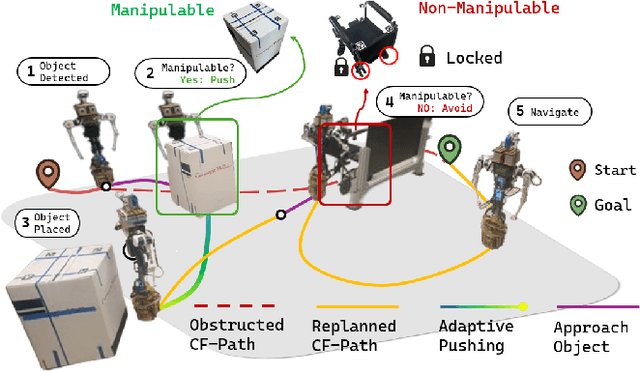
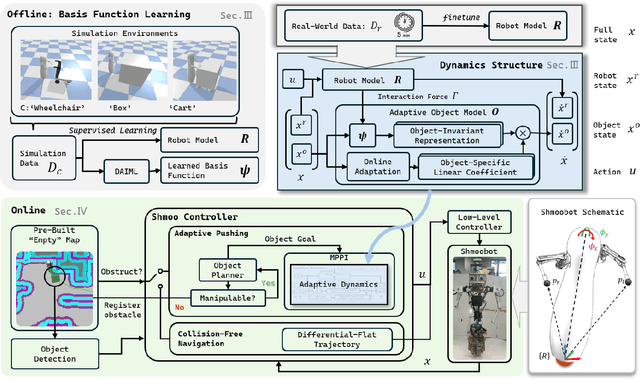
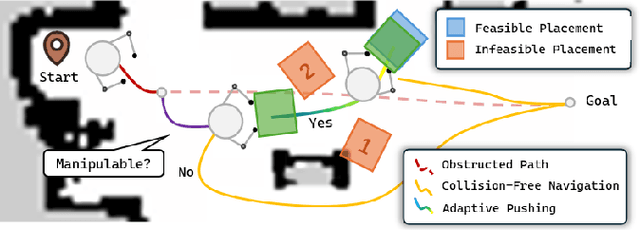
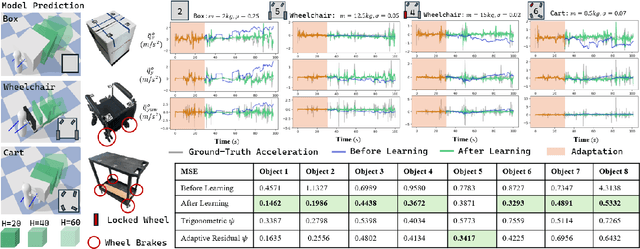
Abstract:This paper introduces a framework for interactive navigation through adaptive non-prehensile mobile manipulation. A key challenge in this process is handling objects with unknown dynamics, which are difficult to infer from visual observation. To address this, we propose an adaptive dynamics model for common movable indoor objects via learned SE(2) dynamics representations. This model is integrated into Model Predictive Path Integral (MPPI) control to guide the robot's interactions. Additionally, the learned dynamics help inform decision-making when navigating around objects that cannot be manipulated.Our approach is validated in both simulation and real-world scenarios, demonstrating its ability to accurately represent object dynamics and effectively manipulate various objects. We further highlight its success in the Navigation Among Movable Objects (NAMO) task by deploying the proposed framework on a dynamically balancing mobile robot, Shmoobot. Project website: https://cmushmoobot.github.io/AdaptivePushing/.
Learning Smooth Humanoid Locomotion through Lipschitz-Constrained Policies
Oct 15, 2024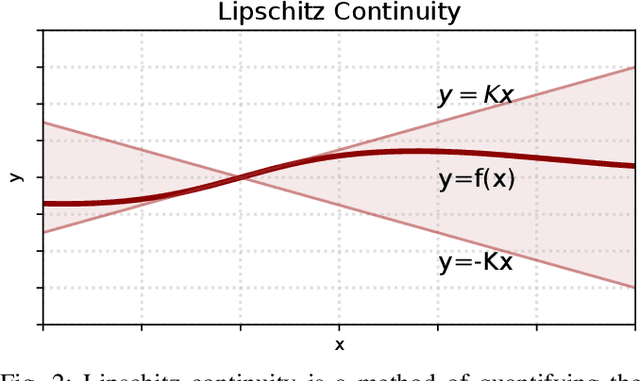
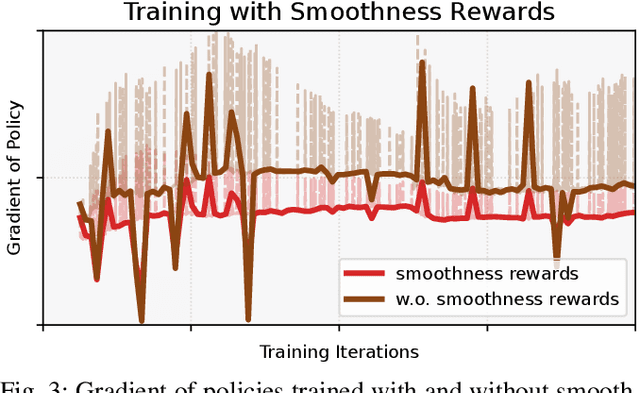

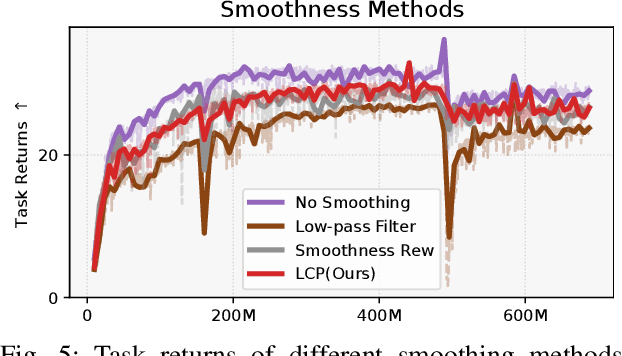
Abstract:Reinforcement learning combined with sim-to-real transfer offers a general framework for developing locomotion controllers for legged robots. To facilitate successful deployment in the real world, smoothing techniques, such as low-pass filters and smoothness rewards, are often employed to develop policies with smooth behaviors. However, because these techniques are non-differentiable and usually require tedious tuning of a large set of hyperparameters, they tend to require extensive manual tuning for each robotic platform. To address this challenge and establish a general technique for enforcing smooth behaviors, we propose a simple and effective method that imposes a Lipschitz constraint on a learned policy, which we refer to as Lipschitz-Constrained Policies (LCP). We show that the Lipschitz constraint can be implemented in the form of a gradient penalty, which provides a differentiable objective that can be easily incorporated with automatic differentiation frameworks. We demonstrate that LCP effectively replaces the need for smoothing rewards or low-pass filters and can be easily integrated into training frameworks for many distinct humanoid robots. We extensively evaluate LCP in both simulation and real-world humanoid robots, producing smooth and robust locomotion controllers. All simulation and deployment code, along with complete checkpoints, is available on our project page: https://lipschitz-constrained-policy.github.io.
Traversability-Aware Legged Navigation by Learning from Real-World Visual Data
Oct 14, 2024Abstract:The enhanced mobility brought by legged locomotion empowers quadrupedal robots to navigate through complex and unstructured environments. However, optimizing agile locomotion while accounting for the varying energy costs of traversing different terrains remains an open challenge. Most previous work focuses on planning trajectories with traversability cost estimation based on human-labeled environmental features. However, this human-centric approach is insufficient because it does not account for the varying capabilities of the robot locomotion controllers over challenging terrains. To address this, we develop a novel traversability estimator in a robot-centric manner, based on the value function of the robot's locomotion controller. This estimator is integrated into a new learning-based RGBD navigation framework. The framework develops a planner that guides the robot in avoiding obstacles and hard-to-traverse terrains while reaching its goals. The training of the navigation planner is directly performed in the real world using a sample efficient reinforcement learning method. Through extensive benchmarking, we demonstrate that the proposed framework achieves the best performance in accurate traversability cost estimation and efficient learning from multi-modal data (the robot's color and depth vision, and proprioceptive feedback) for real-world training. Using the proposed method, a quadrupedal robot learns to perform traversability-aware navigation through trial and error in various real-world environments with challenging terrains that are difficult to classify using depth vision alone.
CurricuLLM: Automatic Task Curricula Design for Learning Complex Robot Skills using Large Language Models
Sep 27, 2024Abstract:Curriculum learning is a training mechanism in reinforcement learning (RL) that facilitates the achievement of complex policies by progressively increasing the task difficulty during training. However, designing effective curricula for a specific task often requires extensive domain knowledge and human intervention, which limits its applicability across various domains. Our core idea is that large language models (LLMs), with their extensive training on diverse language data and ability to encapsulate world knowledge, present significant potential for efficiently breaking down tasks and decomposing skills across various robotics environments. Additionally, the demonstrated success of LLMs in translating natural language into executable code for RL agents strengthens their role in generating task curricula. In this work, we propose CurricuLLM, which leverages the high-level planning and programming capabilities of LLMs for curriculum design, thereby enhancing the efficient learning of complex target tasks. CurricuLLM consists of: (Step 1) Generating sequence of subtasks that aid target task learning in natural language form, (Step 2) Translating natural language description of subtasks in executable task code, including the reward code and goal distribution code, and (Step 3) Evaluating trained policies based on trajectory rollout and subtask description. We evaluate CurricuLLM in various robotics simulation environments, ranging from manipulation, navigation, and locomotion, to show that CurricuLLM can aid learning complex robot control tasks. In addition, we validate humanoid locomotion policy learned through CurricuLLM in real-world. The code is provided in https://github.com/labicon/CurricuLLM
Multiple Rotation Averaging with Constrained Reweighting Deep Matrix Factorization
Sep 15, 2024Abstract:Multiple rotation averaging plays a crucial role in computer vision and robotics domains. The conventional optimization-based methods optimize a nonlinear cost function based on certain noise assumptions, while most previous learning-based methods require ground truth labels in the supervised training process. Recognizing the handcrafted noise assumption may not be reasonable in all real-world scenarios, this paper proposes an effective rotation averaging method for mining data patterns in a learning manner while avoiding the requirement of labels. Specifically, we apply deep matrix factorization to directly solve the multiple rotation averaging problem in unconstrained linear space. For deep matrix factorization, we design a neural network model, which is explicitly low-rank and symmetric to better suit the background of multiple rotation averaging. Meanwhile, we utilize a spanning tree-based edge filtering to suppress the influence of rotation outliers. What's more, we also adopt a reweighting scheme and dynamic depth selection strategy to further improve the robustness. Our method synthesizes the merit of both optimization-based and learning-based methods. Experimental results on various datasets validate the effectiveness of our proposed method.
CONDA: Condensed Deep Association Learning for Co-Salient Object Detection
Sep 04, 2024
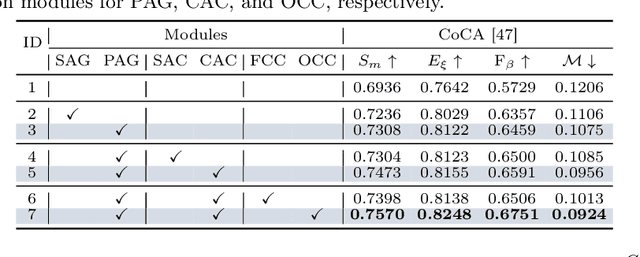
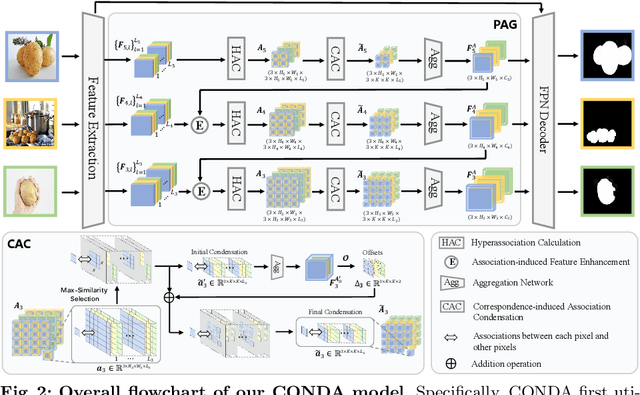
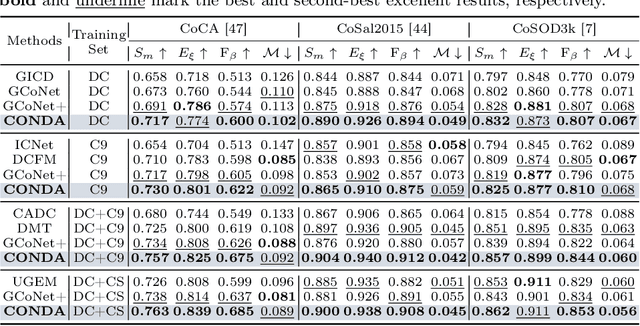
Abstract:Inter-image association modeling is crucial for co-salient object detection. Despite satisfactory performance, previous methods still have limitations on sufficient inter-image association modeling. Because most of them focus on image feature optimization under the guidance of heuristically calculated raw inter-image associations. They directly rely on raw associations which are not reliable in complex scenarios, and their image feature optimization approach is not explicit for inter-image association modeling. To alleviate these limitations, this paper proposes a deep association learning strategy that deploys deep networks on raw associations to explicitly transform them into deep association features. Specifically, we first create hyperassociations to collect dense pixel-pair-wise raw associations and then deploys deep aggregation networks on them. We design a progressive association generation module for this purpose with additional enhancement of the hyperassociation calculation. More importantly, we propose a correspondence-induced association condensation module that introduces a pretext task, i.e. semantic correspondence estimation, to condense the hyperassociations for computational burden reduction and noise elimination. We also design an object-aware cycle consistency loss for high-quality correspondence estimations. Experimental results in three benchmark datasets demonstrate the remarkable effectiveness of our proposed method with various training settings.
* There is an error. In Sec 4.1, the number of images in some dataset is incorrect and needs to be revised
 Add to Chrome
Add to Chrome Add to Firefox
Add to Firefox Add to Edge
Add to Edge